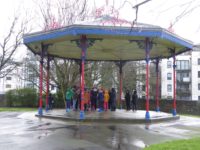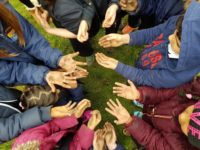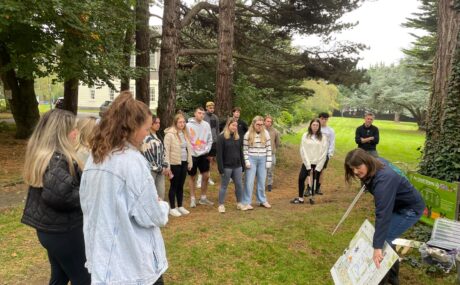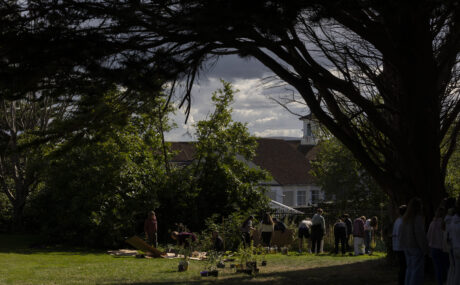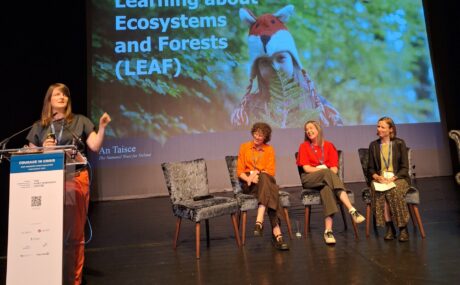An Choill Bheag is a long-term educational restoration programme, and an initiative of LEAF Ireland. Choill Bheag is a small, dense, biodiverse native woodland habitat planted on college, school and community grounds. Choill Bheags are outdoor living classrooms, with space created for seating. As these habitats mature, nature trails can be developed and participants can learn the necessary skills to maintain, monitor and study this essential and beautiful ecosystems. It is based around practical sustainable tree planting and long-term woodland and eco-system education, management and practical skills. It has a strong emphasis on creating the woodland and hedgerow habitat that are then studied and managed as part of a longer-term educational initiative.
These habitats provide an educational and recreational resource for the whole college, school community, enabling participants to engage in Citizen Science, Woodland Skills, Nature Connection and Wellbeing. It also links with the GLOBE and Green-Schools Programmes, Global Goals, Global Action Days, such as National Tree Day, National Tree Week, Biodiversity Day, Climate Action Week and other environmental programmes. Many other subjects can be taught in this outdoor space, including Gaeilge, Geography, History and Art, transforming the school grounds into a Living Classroom.
It is essential that the participants are involved in the entire process, along with the wider community. The Choill Bheag initiative is open to colleges, schools, communities and businesses. To date, we have planted 52 little woodlands / hedgerows under the Choill Bheag initiative. This has all been made possible with a generous donation from Paul Simon, who donated to organisations doing positive work on the ground, while touring in 2018, and funding from the JS Greene Memorial Foundation, Local Authorities, Government departments and businesses.
Woodlands and Forests are critical habitats for the health of our planet. They are vital for: biodiversity, flood control, storing carbon, cooling the atmosphere, soil fertility, regulating and filtering water and nutrients. There is a web of fungi mycelium under the soil connecting all the trees and plants together. This is how they transport nutrients and water and communicate. It is the original ‘World Wide Web’: invisible and under our feet! Woodlands and Forests are essential places for us to spend time in nature for our health and wellbeing. They also produce timber, fuel, medicine, fibre and other products. Planting trees is one of the most vital actions any of us can take for climate action and biodiversity protection for future generations.
The space planted is usually 200m2, with ~200 trees of mixed native species, appropriate to soil type and local conditions. Larger spaces can also be considered, or if space is limited, a mixed native hedge and small woodland could also be an option. Hedges are linear woodlands and essential ecological corridors for both wild plants and animals.
Once the trees are planted, the ground around the trees is mulched. Mulching is when a material is put on the ground to supress grass competition. The materials used are cardboard with bark and grass mulch or biodegradable mats. Mulching also helps to keep moisture in the soil and can provide a habitat for bugs, plants and fungi. Longer-term maintenance involves teaching the school how to control ‘weeds’ and grass competition with continuous mulching and trampling.
Understory planting is carried out after the tree planting, introducing wild plants that will act as ground cover and increase the biodiversity in this habitat.
Over time, several layers will develop, these include the canopy, understory/shrub, climbing, herb, ground covering and underground layers.
Case studies
It’s cool to know that after we leave school the trees we planted will still be there
Working in An Choill Bheag pupils enhanced their questioning skills to collect knowledge and reliable information leading them to make well informed decisions.
Related News
Videos
Choill Bheag (previously known as Tiny Forests) are small native woodlands. In 2017, LEAF Ireland received additional funding from the JS Greene Memorial Fund, it was decided that LEAF Ireland would initiate the Choill Bheag project. Four LEAF schools took part: Scoil Mháthair Dé, Fedamore NS, Limerick Educate Together and Our Lady Queen of Peace, Limerick. 200-400 trees were planted in the school grounds, in total 1200. The physical work was done by the students and teachers under the supervision of the LEAF Team.
Since the making of this video, LEAF Ireland, received further funding from JS Greene Memorial Foundation plus a generous donation from Paul Simon, who donated to organisations doing positive work on the ground, while touring in 2018, which has allowed planting to continue.



